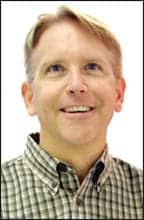An Interview with Kirk Ririe, cofounder and CEO
 |
| Kirk Ririe, cofounder and CEO |
For almost 2 decades, Idaho Technology, Salt Lake City, has been developing novel products in DNA amplification and PCR technology. Established in 1990 by three colleagues in Idaho Falls, Idaho, the company’s production and engineering operations were originally housed in cofounder and CEO Kirk Ririe’s family potato equipment shop. In the late 1990s, the company permanently relocated all its operations onto the University of Utah Research Park campus. Self-financed from the beginning, the company has operated profitably every year since its inception. CLP recently spoke to Ririe about advances in PCR technology and paving the way for putting molecular diagnostics in every lab.
CLP: What was your role in founding Idaho Technology?
Ririe: My role was working with some very talented people, including Carl Wittwer, a pathologist at the University of Utah, and Randy Rasmussen, a PhD student and friend. The three of us came up with a lot of the early products together, and then I would actually build them up in our assembly plant in Idaho.
I work best at the intersection between hardware, software, and the chemistry. Carl comes up with great inventions on the chemistry side, and then I work with engineering teams to implement them.
CLP: What drives your company’s search and development for new technologies?
Ririe: We look for cool stuff. We look for unmet needs in the marketplace, like everyone else, and then we have a set of tools we can use—Hi-Res Melting, real-time PCR, etc—and we look for how we can apply those tools to meet unmet needs.
CLP: Tell us about some of your latest technologies.
Ririe: Our core technologies are high-speed real-time PCR, high-resolution DNA melting, and—more recently—sample preparation. Our most recently launched instrument is the LS (LightScanner) 32, which is the highest-speed, real-time PCR plus high-resolution melting instrument. Our next platform, the FilmArray, integrates sample preparation with those elements.
CLP: What are the capabilities of the FilmArray? What needs will this system meet in the clinical marketplace?
Ririe: The FilmArray is aimed at initially achieving a moderate complexity, but, ultimately, CLIA-waived status, where it will sit very close to the patient and can provide rapid, 1-hour high sensitivity and specificity for a wide variety of different pathogens. It integrates sample preparation and a two-stage nested PCR technology.
Our first product is a respiratory pathogen panel, which tests for 21 targets both bacterial and viral, and that product is really aimed at critical care. If you have someone in respiratory distress and you want to know rapidly what the pathogen responsible is, you have to be able to load a sample, push a button, and walk away. That’s exactly the capability the FilmArray has. It takes only a few minutes of training. People can watch a run and then operate the instrument. It also takes less than 5 minutes’ hands-on time to set up a run. The rest is up to the machine.
CLP: Can you explain how multiplex PCR represents advancement over existing methodologies?
Ririe: In particular, nested multiplex PCR technology is exceedingly sensitive. It offers the sensitivity of nested PCR, but it offers it on a multitude of different assays. So you can run a highly multiplex reaction because it’s split into these two components: up-front multiplex PCR, and then an array of single-plex PCRs that essentially use that preamplified reagent as a reagent for a second-stage array of PCRs. Using this technology you can offer exquisite sensitivity, and you can test for a multitude of different pathogens, or genes within a set of pathogens. That’s the primary advantage.
CLP: Let’s talk about some of the existing barriers that clinical labs may face when implementing PCR technology, such as expense and ease of use. How does your PCR technology overcome these obstacles?
Ririe: When a lab looks at bringing in molecular techniques, they immediately look to large automated solutions—multiple large instruments. Each of those instruments requires multiple trained personnel, and the investment—when you consider everything required to go from the sample to the answer—is very substantial.
The FilmArray takes a completely different approach, one where you take a patient sample and put it into a moderately priced instrument that does everything from sample to answers—not one answer, but a multiplex answer—within the time frame of a doctor’s office visit.
Part of our goal is to dramatically reduce the cost barrier to entry. But more importantly, to decrease the labor and complexity of the system so that less trained personnel can operate it.
CLP: What are some of the different challenges between developing products for the clinical lab instead of research labs?
Ririe: The most obvious difference is the degree of the barriers to entry on the clinical side, which are very well known. We went through that first on the JABAIDS program, a biothreat detection system we worked on with the Department of Defense, and we’re now embarking on the much more substantial process with the FilmArray. As far as building quality instruments and delivering chemistry that works, I think the challenges are more or less the same. However, the stakes are much higher in the clinical diagnostics business.
CLP: Can you elaborate on how developing the FilmArray for the market has been more challenging?
Ririe: What we’re aiming to do is something no one has done before. There is no directly competing platform at the moment, and that is a challenge from a regulatory standpoint because you are going into uncharted territory and you have to figure out with the FDA a lot of things about the approach to clearing such a product.
CLP: Do you expect every lab to be able to implement this technology? If not, which labs are right for exploring it?

To keep up with developments in PCR technology, bookmark our website. |
Ririe: Our belief is that we’ll be able to get moderate complexity in our current FDA clearance effort. Currently, that opens the door to a lot of hospital labs and some of the larger clinics. Is it right for absolutely every place? The answer is currently no, but if and when CLIA is waved, it opens the door to a very large number of labs that would be very close to the patient that could significantly affect treatment.
CLP: When can we expect to see the FilmArray hit the market?
Ririe: We are currently performing analytic studies, and we have just begun clinical trials, or evaluations, which will run through this flu season. We hope to have all the paperwork in place by summer and be ready for a launch in time for the next flu season, next fall.
Stephen Noonoo is associate editor of CLP.




